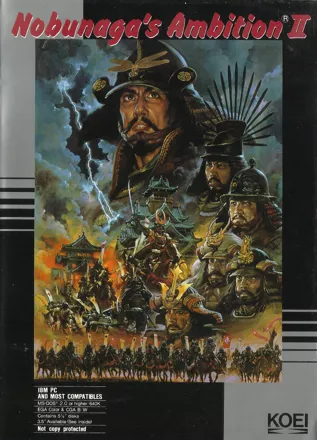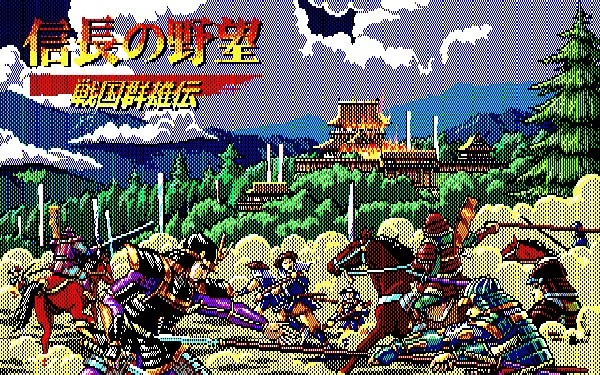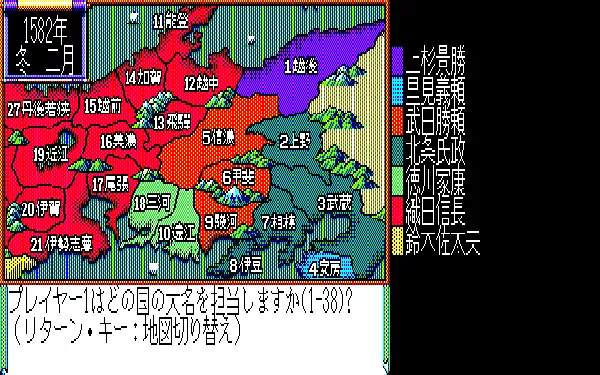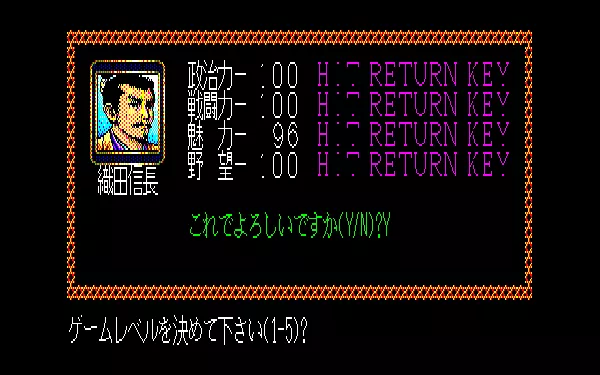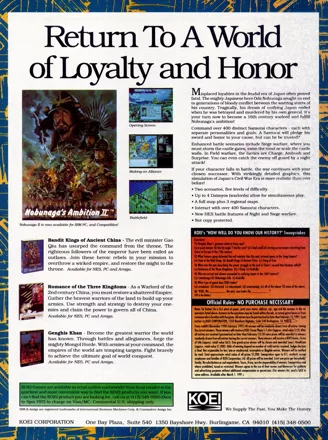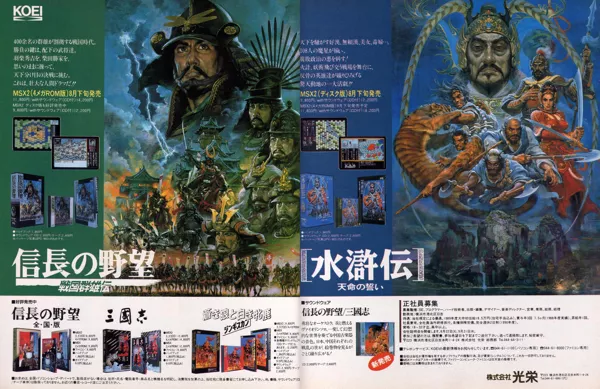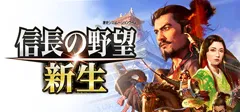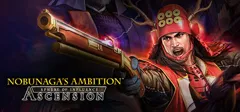Nobunaga's Ambition II
Description
Nobunaga's Ambition II is the sequel to Nobunaga's Ambition. The setting is 16th century feudal Japan, a period when ruthless daimyo (feudal lords) contended with each other for dominance. Ultimately, the winner in this struggle will become Shogun and hold actual power over the islands, while being nominally subject to the Emperor.
The game casts the player as one of the daimyo, allowing them freedom to decide the fate and future of feudal Japan, through diplomacy and ultimately war. The objective is to unify Japan under the player's rule. If the player fails through death on the battlefield, assassination at the hands of a ninja, or through natural causes, they can choose a successor and play on. Functionally, the first job is to let prosper the fief (province) under the player's control through agricultural development and town investment.
There are two scenarios available in the game: * Warlords: 1560 A.D.
The first scenario begins as the daimyo prepare what will eventually become a full scale war in the whole of Japan. The warring states period begins here. There are 28 of them included in the scenario, among others: the Mori clan, the Takeda, the Hojo clan, the Uesugi clan, etc.
- Nobunaga's Ambition: 1582 A.D.
The second scenario follows the rise of Oda Nobunaga in 1582 A.D. to power and allows the player to play either as Oda Nobunaga or as one of his chief allies or rivals.
Samurai
The game improves on its predecessor by including some 400 historical samurai in the game, providing the player with generals for troops and governors for a conquered fief.
Each samurai is characterized by statistics: Age, Rank, Body Points, War, Politics, Ambition, Charisma, and Loyalty. There are also additional attributes for specific military purposes: Skill, Arms Level, and Unit Type. Some of these attributes may be improved through training (i.e. war, politics, and skill), rewards (i.e. loyalty), or through merchants (i.e. arms level).
Strategy
The game is turn-based, with each turn representing one month. Certain events take place annually such as tax collecting (March) and rice harvest (September), while other events, such as invading neighbors, follows the player's time table.
The game uses an initiative system to determine what actions can be completed in a particular month. Each daimyo and samurai has a stock of "Body Points" that represent the attention he can afford to spend on an action. Each action has a cost in Body Points for the character executing it, and if he does not have the point’s necessary, he may not perform it. Body Points are refreshed a little each month. The level of Body Points refreshed per month is depends on the level of his Political skill. Intensive operations will deplete Body Points and then require turns of inaction to stock up again, so timing actions to coincide with Body Point availability is an extra wrinkle to the management of resources.
Combat
Each samurai can lead a 100-strong unit, which must be recruited, then trained, and equipped with weapons for battle. The attack of an army results in a tactical play out of the resulting battle or siege. A hex-based map of the area of the battlefield will form the playing board for the movement to combat and actual fighting. Fortifications (castles) have a dramatic benefit for the defender. The attacker must defeat the defender within 30 days or must force a withdrawal. Additionally, both sides must pay attention to their food provisions as each day subtracts food supplies in accordance to their army size. Unit Types The game introduces 3 basic military unit types: Infantry (Inf), Cavalry (Cav), and Rifles (Rif). Each unit type has certain special abilities and tactical advantages/disadvantages in combat: + Infantry have the ability to ambush anywhere on the main fief map (explained later) and have 4 movement points; + Cavalry have the ability to charge at an enemy (inflicting considerable damage on both sides) with the chance of breaking through the defending unit and emerging on the other side. Samurai leaders may often be killed (instead of captured) if their unit reaches zero. Cavalry have 6 movement points; + Rifles may attack using muskets which have devastating offensive capabilities, which may also kill an enemy samurai unit if the opponent's unit reaches zero (thus, a standard non-rifle attack is also available for capturing an enemy samurai leader). Rifles have 3 movement points.
Additionally, both Infantry and Rifle units may move over walls or through water during the castle siege for a certain amount of movement points.
Tactical Combat
Tactical combat occurs in two different locations:
The first is the tactical map of the fief, where the attackers first arrive and the defenders surrounding the castle. In this setting, each days is divided into three time periods: morning, afternoon, and night, before the day ends. At night, armies may maneuver to surprise attack enemies in the dark, which does considerably more damage than an average attack. This may be done if the enemy is at least two squares away (not adjacent).
The second is the castle siege map, which occurs if the defender chooses to retreat to the castle from the previous map. Here, each turn represents one day, thus the time limit of the attack as well as the provisions of both sides, rapidly decrease with each turn. In this setting, the siege force must break down gates leading towards the castle for the final engagement. The defender is defeated, if the governor of the fief retreats, or if his unit is destroyed: resulting either in his capture or death.
The end outcome is either the fall of the fief to the attacking forces or victory for the defenders. Either way, captured samurai (if any) will require a prompt response for release, beheading, or recruitment to the winner's force.
Spellings
- 信長の野望・戦国群雄伝 - Japanese spelling
Groups +
Screenshots
Promos
Credits (DOS version)
| Concept and Producer |
Reviews
Critics
Average score: 81% (based on 3 ratings)
Players
Average score: 4.1 out of 5 (based on 8 ratings with 1 reviews)
No one describes Medieval Japan better than KOEI.
The Good
Review Version: v2.1 - My grammar sucks to the point of unbelievable sometimes.
Review Date: November, 2008
Review Length: 5 page(s).
Game Version: v1.0
Tech Specs Used: Emulator
Daimyo’s Played: Oda Nobunaga, Takeda Shingen, Asai Nagamasa, Honganji Kosa.
Finished: No. Don’t plan to either.
Last time played: Always. This is my version of Solitaire.
Apart from the Romance of the Three Kingdoms (RTK) series, this has to be my next favorite in line of the Historical Series introduced by KOEI. Compared to RTK, Nobunaga's Ambition 2 maybe a little less complex to play, but also easier to comprehend. I’ve played this game for more than 10 years (when it still came in two 5 1/4 diskettes) and is one of those games that will forever be in a fanbois’ hard drive. I believe I have possibly conquered every and all stratagem there is in this game. Despite that, I have no intention of finishing the game…for reasons I’ll explain later in this review.
The game takes place in medieval Japan, an era where everyone (warlords or daimyo) was at war with everyone. Similar to other games from KOEI Historical Series, the aim of the game is simple: Conquer the whole map...with you as the supreme ruler.
The Daimyo’s and the Samurai
There are many main characters here you can choose from. Favorites can be seen from their statistics naturally...the higher their stats, the bigger chance their role in the game (and usually the more famous they are in actual history), in addition to their unique graphical portraits. The game usually revolves around these characters: Oda Nobunaga, Takeda Shingen, Uesugi Kenshin, Imagawa Yoshimoto, the Hojo Clan, the Miyoshi Clan, and the Mori Clan (at least, in the game, these are the daimyo’s that have the most ambition, i.e. they attack a lot!)
All these clans possess the greatest forces and highest ambition to "change the lay of the land"... compared to other daimyo, who only act as "additional features"...since historically they didn't present that much a change. Simply put, like many other KOEI Historical Series games, famous or historically identifiable persons in the game usually have a "detailed portrait". Whereas normal “fictional” samurai usually look very much alike.
During my youth, my favorite character was (naturally) Oda Nobunaga...or sometimes Takeda Shingen. Though honestly, my main reason in choosing characters is if they have the handsome "hero" kind-of-look. So there’s probably no chance in hell I’d choose the Ashikaga or Rokkaku clan (not good looking enough). However, later in my adulthood, using these “favorite” daimyo’s became less challengeable, so I picked other underdog daimyo’s (but equally good looking) such as Asai Nagamasa and Honganji Kosa…which indeed is every difficult in comparison, due lack of skillful samurai and advisors to advise your every decision.
One of the very special trade marks of KOEI historical games, is that players tend to unconsciously memorize the stats of characters in the game. I practically memorized the names and stats of almost all great samurai, which is often funny when meeting another fan of the game, sizing up our knowledge of the game by how many stats we memorize. Yes, nerds are weird. :)
Strategy
Like most strategy games, the way to win is to understand the many factors in that particular game. In Oda Nobunaga's Ambition 2, these elements consist of:
- Military Might
Naturally, the more samurai you have, the more soldiers you can control with each samurai: an important power check with neighboring Daimyo’s preying for an ill-prepared fief. A fief or province can only hold 20 samurai, so sooner or later you need to expand your realm. Each samurai has a maximum of 100 soldiers. Numbers however, are not enough: You need to train your samurai - a force of 100 trained samurai can defeat almost 500 untrained samurai (depending on your strategy). This also goes for arms. A sharp katana will do more damage than a rusty chopstick! Food is an essential factor in war. Make sure to go into battle with rice bags fresh from the field...it is dishonorable to retreat from the battlefield due to an empty stomach. Unit types also provide an edge in any battle. There are only 3 unit types here: Infantry, cavalry, and riflemen. Infantry have the ability hide in forests and ambush unwary approaching enemies, conflicting devastating damage. Cavalry can charge any unit in hand to hand combat, reducing numbers of the enemy in an ongoing onslaught. Riflemen inflict the greatest damage to any unit brave enough to come to close to its firing range. Make sure you castle is at maximum defense while you’re at it... - Diplomacy
Allying yourself or sending gifts to other Daimyo's is essential in survival. Although, in my experience, I have never actively used diplomacy as it made little difference in game play. Diplomacy was something more what other Daimyo's did to you. Often they offer money, request alliances, or even request your daughter's hand in marriage. You never seem to run out of daughters by the way. - Espionage
What the samurai cannot do without dishonor, the Ninja comes to take the role. Espionage consists of gathering information of other fiefs, spreading war rumors to incite the locals, or even assassination of an enemy Daimyo. Either which, success depends on the ability of the recruiting samurai (political skill) or else his ninja may get caught in the line of duty. - Economy
Nothing is more important than the flowing of gold coins and rice from paddy fields. You can develop agriculture or town centers. Money comes in every March and the harvest comes in every September. The cycle makes it easier to focus on which to develop first. Developing increases local support, while high taxes lower it. Taxes (money or rice) are always done manually, which is very important as it always seems to be a different need every year. Developing towns increases your fief's cultural value. The higher the culture, the higher stats your samurai will receive when doing personal training. - Leadership/Samurai Development
My favorite feature, due to the RPG-ness of it. Recruiting samurai from other Daimyo's is like killing two birds with one stone:
[1] Gaining more samurai while;
[2] Lowering the number of samurai (and soldiers) of the other Daimyo. Make sure their loyalty is rewarded by gold or their service with you maybe brief. No matter how good looking a samurai is, you can't ignore his stats. Low politics makes him slow to recover his body points; low war means you can't rely on his abilities in combat. Thankfully, the great feature in this game is you can develop their stats to the maximum level. The development of your samurai is highly influenced by the cultural level your samurai resides in and by the most intelligent samurai residing there. A samurai can only learn a 5 point difference from the smartest samurai. So if you have a samurai with 100 a war stat, his pupil can only achieve a maximum of 95...which is more than enough!
**The Bad**
Character Selection
One of the most irritating things you have to do before playing this game is to pick a ruler. After that you have to randomly choose his stats. Being a perfectionist in this area, I can't seem to pull myself to receive any less than his maximum stats. So, unless you’re forgiving and patient, one can spend a lot of time waiting for that perfect stat for your Daimyo. For example in the Warlords campaign, Oda Nobunaga’s maximum stats are Politics (100), War (100), Charisma (100), and Ambition (97). So you can imagine how many minutes to hours I have to retry getting those stats. Sucks being a hardcore gamer sometimes. :) AI Cheat
I've noticed you can lose if your "caught unprepared". This means that an enemy Daimyo attacks you when the body stat of one of your governors 0 (zero) lower than 20. However, the problem is that there is no way the other party can know the body stats of any enemy samurai. The only way to gain information on another fief is to send a ninja. They portray almost all information available, except body stats. Somehow, the enemy AI always knows when you’re over-working. The body stat is technically invisible to all except you. Turn-Based Issues
Taking turns in the political map is somewhat problematic. Firstly, you don’t know which of your provinces goes first. This is only an issue when you have supplies to send, deal with merchants, or sometimes even planning offense. Another problem lies in defending. I’ve been in situations where the opponent from a same province can somehow attack me twice. When you attack, it also acts as an “end turn” choice. So when an enemy attacks, it means that he has ended his turn. One would think that after successfully defending a fief, you would have a chance to re-organize your troops. Apparently not. If any enemy or defending governor has his troops reduced to 0 (zero), it usually means that the leader is captured. If released, the Daimyo or samurai (acting as a governor) returns to an adjacent fief. Releasing captured Daimyo’s can be a serious problem for that particular Daimyo being released. Due to the “turn-base issues”, it is possible that the Daimyo is attacked before he has a chance to re-organize his troops. Thus, he is in a constant “caught unprepared” situation, which means an automatic defeat. This may occur about 2 or 3 times, depending on the “luck factor” of him getting a turn to re-organize or simply the attacking samurai runs out of body points to commence the invasion even further. Samurai Dying by Natural Causes
May it be from old age or by the plague, samurai dying under peaceful circumstance is problematic. Why? Because when he dies, the soldiers under him also “die” or to be more exact, they simply disappear. You do not have the chance or option to re-assign those soldiers to another samurai. This feature because a serious defense disability when you dying samurai is a governor. If he dies, you can choose another samurai as governor. In the circumstance that other samurai do not have troops or not enough troops to thwart an attack, your fief suddenly becomes easy prey for ambitious neighboring warlords. Remember the “caught unprepared” situation. That really sucks. Stalemate
Sometimes all the provinces become quite balanced in military strengths. Considering I play a defensive role, usually focusing on maximizing my samurai and fief first, rather than just mowing the whole of Japan, I often come to a situation where no one is acting anyone. The AI attacks only under certain situations. They will almost never attack any fief that has a considerable defending force. AI with low ambition almost never attacks. So sometimes, you have to actively “provoke” disorder in Japan, by attacking or intentionally making certain fiefs weaker (by recruiting samurai or spreading rumors) so it will be more attractive to attack by other AI. Conquer Japan?
The game suffers similar defects in almost every strategy game in existence. The best challenges throughout the game only occur at the beginning of the game. When you become more established, with rich fiefs and stronger samurai…you tend to lose interest in continuing the game for the final goal of ruling Japan, although this may only be something that applies to me. I have never wanted to conquer the whole of Japan as, when it comes to the point where I have the power to actually do so, the challenges have become ridiculously easy. Mowing down every samurai in Japan is only to easy, however there isn’t a good enough reason to do so, as the game doesn’t have stories or other events worth mentioning.
**The Bottom Line**
This game practically helped me memorize almost every Japanese samurai clan there is, as well as the name of the provinces, as well as the historical politics and geography. It is has since then been my primary framework in Japanese history until other more detailed games came along my path. Now every time I hear the name Suzuki, Honda, Takeda and many other familiar Japanese clan names, I remember that this game gave me that knowledge...which I found to be quite interesting conversation with Japanese girls. :p To me it is an A-rated historical strategy game, and very much playable today.
DOS · by Indra was here (20756) · 2008
Analytics
Upgrade to MobyPro to view research rankings!
Identifiers +
Contribute
Are you familiar with this game? Help document and preserve this entry in video game history! If your contribution is approved, you will earn points and be credited as a contributor.
Contributors to this Entry
Game added by Professor.
FM Towns added by Trypticon. MSX added by chirinea. PC-88, PlayStation, Sharp X1, SEGA Saturn added by Infernos. Windows added by johnny fiveaces. Sharp X68000 added by Kabushi. FM-7 added by Игги Друге. NES added by larrylau69. PC-98 added by Unicorn Lynx.
Additional contributors: Игги Друге, gbcat.
Game added April 9, 2002. Last modified March 12, 2023.
